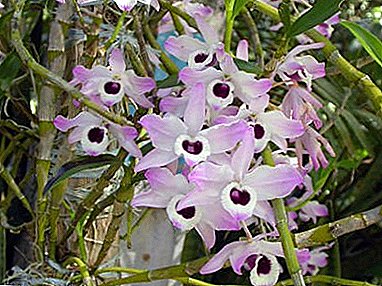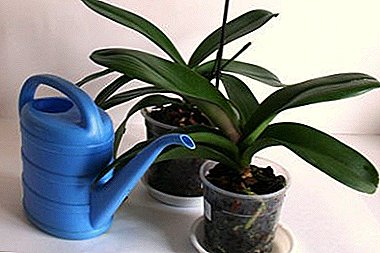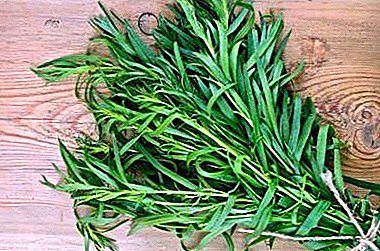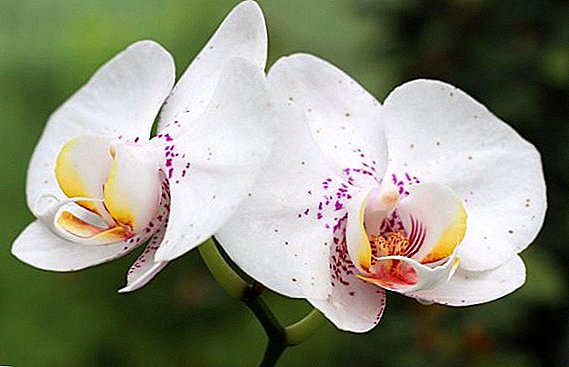
Dendrobium orchid is an exotic plant with powerful juicy shoots and beautiful fragrant flowers. The plant is very easy to adapt to home conditions.
Caring for this orchid is not difficult. Dendrobium orchid is a houseplant, bad for frequent transplants. How to carry out this procedure correctly, without harming the delicate plant, you will learn in our article. You can also watch a useful video on this topic.
When do you need to repot the flower?
Transplant is an important part of plant care.. It may seem that the land is still quite suitable for growing a dendrobium orchid, but perhaps it has already lost its beneficial properties. Namely, air permeability, acidity, balance of salts. It often happens that as a result of frequent irrigation and fertilizer, the soil becomes dense. Therefore, to the roots of the flower comes every time less and less air.
 When watering with tap water gradually increases the ph of the substrate, as a result, the dendrobium orchid stops receiving useful elements from the environment. And the roots are spoiled altogether from clusters of potash and phosphorus salts. Considering all these subtleties, it is necessary to replant the plant 1 time in 2-3 years, sometimes it is possible and more often.
When watering with tap water gradually increases the ph of the substrate, as a result, the dendrobium orchid stops receiving useful elements from the environment. And the roots are spoiled altogether from clusters of potash and phosphorus salts. Considering all these subtleties, it is necessary to replant the plant 1 time in 2-3 years, sometimes it is possible and more often.
Also, the plant must be transplanted if the roots have grown strongly and are displacing the substrate from the pot. It is imperative to repot the flower when rot or pests appear.
After buying a dendrobium orchid in a store, you need to start transplanting right after the end of floweringor in the first year after purchase. The substrate in which the plant is located in the store is not suitable for growing a flower at home. The best time to transplant orchid dendrobium is spring. Spring is considered the beginning of a new plant growth. At this time there are new shoots and roots.
When can it be harmful?
Transplanting is a stress for the Dendrobium orchid. It is not necessary to replant it during rest and during the rest period.
Main ways
- Transshipment. Suitable in the case when the root system of an orchid grows heavily, the roots are undamaged, the flower itself is healthy, the substrate is suitable for cultivation. This method allows you to save earthen room, while for the orchid adaptation is less painful.
- Transfer. This method consists in the complete cleaning of the roots from the substrate.
How to choose a pot?
- Dendrobium orchid should be planted in special blocks, orchid baskets or pots.
- Pots should choose from clay or plastic. Clay pots are preferable because they can provide the plant with the necessary resistance from overturning.
- The size of the pot is recommended to choose in accordance with the size of the root system. The roots should calmly enter the pot.
When lowering the roots in a pot, about 2 cm of free space should be left around the edges.. Be sure to lay out the bottom of the pot drainage. Drainage can serve as pebbles, expanded clay or foam. The drainage layer must be at least 3 centimeters.
Proper soil selection
 A feature of the orchid dendrobium is not living on the ground, but existence. Attached to the trunks, roots and branches of trees.
A feature of the orchid dendrobium is not living on the ground, but existence. Attached to the trunks, roots and branches of trees.
The easiest way is to buy land in the store. You can prepare the soil yourself. To do this, it is necessary to shift the bark of coniferous trees, fine expanded clay, crushed moss, coconut fibers, charcoal and fine peat. If the substrate is prepared by itself, then it must be disinfected. Or boil on the fire for about 3-4 minutes. Or pour boiling water for 10 minutes. Water after this need to be drained. And dry the ground.
Step by step how to transplant
- Extract from the pot. If the pot is made of plastic. Before removing the dendrobium orchid from the pot, be sure to slightly wrinkle the walls with your hands. Thanks to this substrate will be better to give in. Next, you need to gently pull the flower out of the pot. To facilitate the task, you can place a flower in a pot in a container with water, which will help the roots to soak. If you still can not pull out, you will need to break or cut the pot.Attention: The root system of a flower can be very strongly developed, the roots intertwine with each other, this will complicate the transplant process, since it will be quite difficult to get rid of the substrate. A weakened plant is much easier to replant, it is easy to get out of the pot.
- Washing the roots and getting rid of excess substrate. Be sure to remove the bark from the rhizome of the orchid dendrobium. Cleaning is quite simple. In a bowl of warm water, you must place the orchid for 15-20 minutes. During this time, the substrate will soften. After that, it is already possible to stir and unravel the roots with your fingers. This procedure is carried out in water, in order not to damage the roots. Dirty water should be washed off. If there are hard to reach places, you can use the shower. No need to try to clear all the roots of the old bark. If the particles of the bark are badly separated from the roots, you can not touch them.
- Inspection of roots and removal of diseased processes. Purified root system is easy to inspect. It is necessary to remove all rotten and dry parts. If the roots have damaged areas, they must be trimmed. To do this, you can use a knife or scissors. Be sure they should be disinfected with alcohol or hardened with fire so that the plant does not get sick. Cut areas need to be treated with charcoal or activated charcoal. A healthy orchid root system Dendrobium is solid and durable. Not having a void. The color of the roots is white or green.
- Drying plants after washing. Treated dendrobium orchid roots are recommended to be dried for two hours at room temperature. The best option is washing in the evening, then drying can be carried out all night, and in the morning you can do the transplant.
- Move to new tank. In the pot on the drainage layer is recommended to pour the chips of pine bark. Dendrobium orchid should be placed in a pot in the middle. Next, you need to bark the roots of the plant with bark, pseudobulbs should remain on the surface. If the plant is already large, you can attach wooden sticks to it for stability. It is necessary to remove props only when the plant takes root.
- Watering. The first watering should be carried out with a transplant of a flower in order to tamp the soil. It should be noted that if the substrate is not dry, or it has been dried for no more than 2 hours, then it is necessary to water it no sooner than 2-4 after the transplant. Water for irrigation should be purified at room temperature, a little more. If this requirement does not comply with the roots can rot.
We recommend to watch the video about the correct transplantation of dendrobium:
What not to do during the procedure?
- In no case can not the plant sections to handle green paint. Alcohol or iodine. Substances that are contained in these solutions, rise through the capillaries up and dry up healthy tissue.
- You can not tear off flower stalks. The plant itself must get rid of dead parts.
- When transplanting it is necessary to ensure that the roots are not intertwined.
A photo
In the photo below you can admire the Dendrobium orchid.



Possible problems
The root system of the dendrobium is very fragile, so it is easy to pest.. When planting, you need to carefully examine the roots for the presence of diseases and pests.
ImportantA: Every time during transplantation, it is imperative to take all necessary measures to prevent infection of a weakened root. Handle tools, pot, disinfect substrate.
It is worth observing the leaves of the orchid dendrobium. If the leaves are green, then the growing conditions are comfortable. If they "turned pale" - it is necessary to move it to another place, perhaps the light is very bright for it, burns may even appear on the leaves. If the leaves are dark or yellow - you should definitely add lighting.
Aftercare
After dendrobium orchid transplantation, it is necessary to provide favorable conditions. Lighting should not be bright. Under the influence of direct sunlight, the plant can overheat and get burns.
Air temperature is preferably about 20-22 degrees. It is necessary to water the plant often, but do not allow stagnation of water in the pan.
Feeding should be carried out during the period of active growth. Humidity in the room should be from 60 to 70%.
We offer to watch a video about flower care:
Conclusion
Dendrobium orchid needs comfortable conditions. If you follow all the rules of caring for a plant, you can admire this bright and fragrant flower for a long time.












